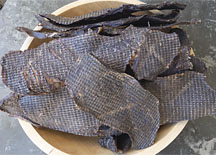How to Make Healthy Beef Jerky or Bison Jerky
re: nutrition
re: How to Make Dried Persimmons
re: Dehydrating Food is Fast and Easy—Here’s How and What to Use for Drying Fruit, Making Beef Jerky, etc
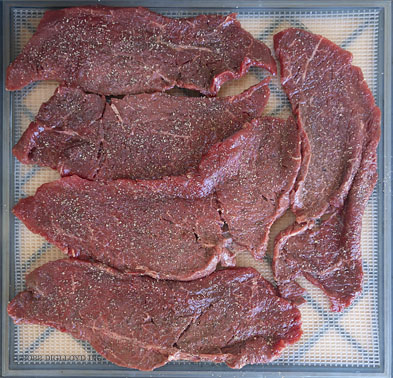
Commercial beef jerky is awful. Starting with factory-farmed meat that is laced with chemicals so it will keep on shelves for 2+ years. The cheapest rawhide-grade stuff can be found at gas stations and similar and it’s often ground mystery meat. The next grade up is still pretty nasty.
Most jerky sold in stores is overly absurdly moist. Yuck! It also means you are buying water along with chemicals added to keep it from spoiling along with an overload of salt and MSG or equivalents. In my experience, moist jerky is invariably low quality in one or more ways, even brands taking pains to claim otherwise.
While top-quality stuff beef jerky can be found, it usually works out to $100 to $120 a pound for grass-fed beef—and you might still get a too-moist product over which you have no quality control.
How much meat?
Figure on a 3.2X weight reduction. A one pound steak is thus 4.9 ounces of jerky and up to 137 grams of protein for a lean cut of meat. Richer cuts may have a bit less protein and more fat and there can be connective tissue of a few grams.
If you like 4 oz of jerky a day (quite easy to eat in a day), then do you want to spend $12 on make-your-own, or $50 or more on commercial?
Near-zero moisture content so dry that a thin piece will snap is ideal for storage. It will keep forever that way, and for hiking/backpacking/travel it’s very light. I like it that way, but you might not, so test it along the way in the drying process.
Which cut of meat?
Beef if the usual best choice. I’d happily prefer bison except that bison is even more expensive than beef. You can use turkey or chicken or velociraptor or goat or lamb, but IMO fowl makes inferior jerky—red meat is best.
Use grass-fed and grass-finished beef* if at all possible (“grass-fed’ is often a scam, with the animal fed corn and soy for 3-4 weeks prior to slaughter, grass fed/finished is the thing to look for).
* The nutritional profile of grass fed/finished is quite different from corn/soy feedlot beef and the taste too (yuck, particularly the fat from corn/soy beef). Cows/cattle are no designed by nature to consume grains (nor are you actually). Bad inputs = bad outputs.
I once was offered New York Steaks at half price because the butcher thought the quality was not there for full price. I made them into my best beef jerky ever—dang that was good stuff!
Point being, while cuts like “London Broil” are oft-cited as good jerky meats, the truth is that fillet mignon, New Yorks, ribeyes (deboned), skirt steak, etc all make superb beef jerky. The higher fat content in those cuts is absolutely preferable for taste and health in my view (assuming it’s grass-fed and grass-finished). The catch is that if your financial situation is anything like mine, $11.99 a pound is already feeling pretty steep on price, and $25 a pound is way beyond my budget. Flank steak was once my lower-cost choice, but it now runs $20 a pound or more (for grass-fed), so I no longer use it for jerky.
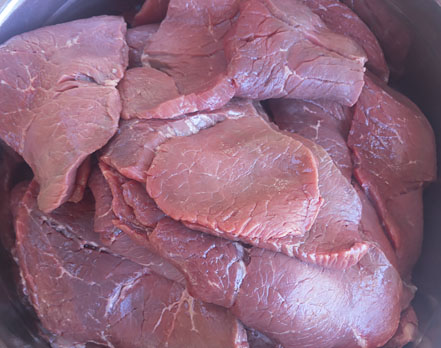
Flavoring
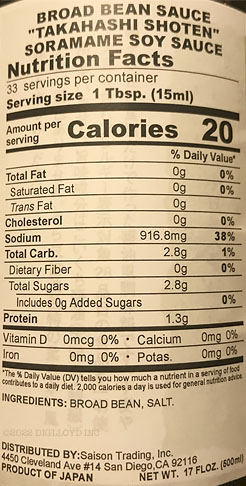
I strongly favor basic natural ingredients. Stay way from commercial frankensauces and similar unless you like industrial food and slow poisoning. Stay away from any commercial beef jerky marinate and especially avoid “natural flavors” (which means artificial levels of MSG).
The only processed flavoring I will consider is classic tamari or wheat-free soy sauce or similar “soy sauce” from beans with ingredients of beans and salt with zero additives. All fermented soy-type products have some level of the excitotoxin glutamic acid. OTOH, so does cheese and meat. I do not know how to evaluate the risk, but at the least avoid added MSG (monosodium glutamate). Use sparingly.
Plain — plain beef jerky is for those who wish to avoid extra sodium or ingredients. It tastes great and works great. If you think it does not, you are likely used to the engineered flavoring of processed foods. Still, a little sodium does taste good, particularly on hikes.
Salt and/or pepper — the salt can be mixed into the meat but be very careful to not add too much, a salt solution is better for controlling the amount. Pepper can be sprinkled/ground directly onto the meat when on the tray.
Soy/tamari — just enough to add some flavor to the meat.
Ginger, garlic, etc — these are all fine but just extra work. Using these is best done with some overnight marinate, which I think is working/trying too hard. Buy better quality meat instead.
Below, I first mixed salt into the meat in the large bowl until all the crystals had dissolved into the meat. Laying the meat onto the trays, I then ground black pepper onto the meat.

Meat preparation
A good butcher can slice the meat 1/4" thick for you. Unless you have the right equipment, the consistency of the butcher’s efforts is far better than I can do on my own with a knife at home.
Do NOT remove the fat—grass fed/finished fat is healthy for you (if grass fed). It is NOT healthy to eat super lean meat by itself; your body wants and needs fat with it. The biggest issue with jerky is being too lean. You would die on most jerky where you to rely on it to get through winter in a tent—protein starvation.
- Place the jerky into a large stainless steel bowl.
- Hand-mix the ingredient(s) into the meat, eg sea salt or your choice of soy sauce or similar. Be sparing—flavor should not dominate the meat (unless perhaps the goal is to mask low quality meat).
- For more sodium absorption or stronger flavor, let the meat soak overnight, but IMO this is usually a mistake, which the flavoring dominating the meat overly much. And it delays getting the drying started.
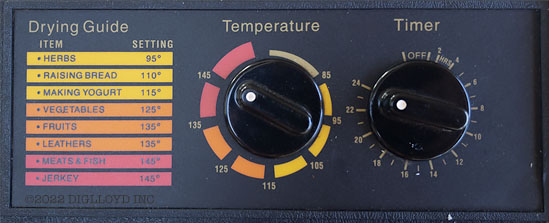
Drying
You’ll need a good food dehydrator, see the discussion.
I set my Excalibur 9-tray dehydrator to 24 hours, which is about right for 1/4" thick beef.
However, there is some variation in thickness, so . I strongly recommend very dry jerky as it will keep a long time.
Drying time will vary depending on thickness; check at ~18 hours or so until satisfied with the finished result. Trays with thinner cuts can be pulled and any thicker cuts can have more time in the dryer.
Retaining moisture may keep the meat easier to chew quickly, but it means potential spoilage. My recommendation is very low moisture content, as it will keep will in a Ziploc bag for many months without any issue. Good beef jerky should be dry, and can be savored as the mouth softens it up—part of the fun.
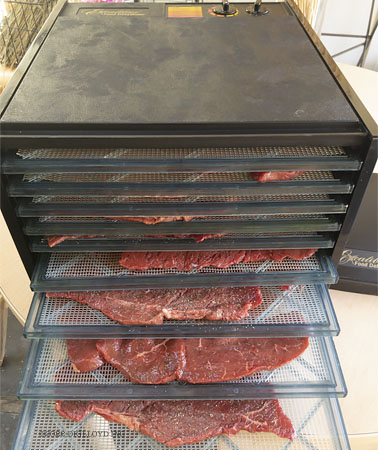
Finished product
For this batch, ~20 hours for complete drying (very dry) of “London Broil” round steak:
15.2 pounds = 6895 grams ===> 4.68 pounds = 2125 grams
A wet/dry ratio of 3.24 Different cuts may produce slightly different ratios due to varying moisture content, fat content, etc.
